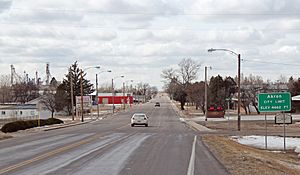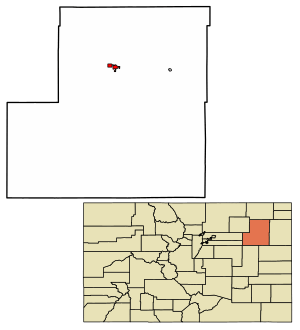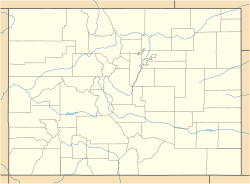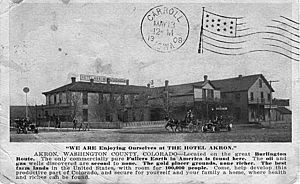Akron, Colorado facts for kids
Quick facts for kids
Akron, Colorado
|
|
|---|---|

Entering Akron from the east (2013)
|
|

Location within Washington County and Colorado
|
|
| Country | |
| State | |
| County | Washington County seat |
| Incorporated | September 22, 1887 |
| Government | |
| • Type | Statutory Town |
| Area | |
| • Total | 2.77 sq mi (7.18 km2) |
| • Land | 2.77 sq mi (7.18 km2) |
| • Water | 0.00 sq mi (0.00 km2) |
| Elevation | 4,659 ft (1,420 m) |
| Population
(2020)
|
|
| • Total | 1,757 |
| • Density | 633.84/sq mi (244.70/km2) |
| Time zone | UTC−07:00 (MST) |
| • Summer (DST) | UTC−06:00 (MDT) |
| ZIP code |
80720
|
| Area code(s) | 970 |
| FIPS code | 08-00925 |
| GNIS ID | 182984 |
| Highways | US 34, SH 63 |
Akron is a small and friendly town in Colorado, United States. It is the main town and the county seat of Washington County. This means it's where the county government offices are located. In 2020, about 1,757 people lived in Akron.
History of Akron
Akron was first planned out in 1882. It began as a small camp for railroad workers. It was a convenient stop halfway between McCook and Denver. The town got its name from Akron, Ohio. This was the hometown of a railroad worker's wife. The Akron post office opened on January 30, 1883. The town officially became a town on September 22, 1887.
Geography and Climate
Akron is located where two important roads meet. These are U.S. Highway 34 and State Highway 63. You can find it at these map coordinates: 40°09′38″N 103°12′52″W / 40.1605°N 103.2144°W.
In 2020, the town covered an area of about 2.77 square miles (7.18 square kilometers). All of this area is land.
Akron's Weather
Akron has a type of weather called a semi-arid climate. This means it's usually quite dry. Winters are cold and dry, while summers are hot and also dry.
Population and People
| Historical population | |||
|---|---|---|---|
| Census | Pop. | %± | |
| 1890 | 559 | — | |
| 1900 | 351 | −37.2% | |
| 1910 | 647 | 84.3% | |
| 1920 | 1,401 | 116.5% | |
| 1930 | 1,135 | −19.0% | |
| 1940 | 1,417 | 24.8% | |
| 1950 | 1,605 | 13.3% | |
| 1960 | 1,890 | 17.8% | |
| 1970 | 1,775 | −6.1% | |
| 1980 | 1,716 | −3.3% | |
| 1990 | 1,599 | −6.8% | |
| 2000 | 1,711 | 7.0% | |
| 2010 | 1,702 | −0.5% | |
| 2020 | 1,757 | 3.2% | |
| U.S. Decennial Census | |||
According to the 2000 census, Akron had 1,711 people. These people lived in 734 households. About 457 of these were families. The town had about 1,179 people per square mile.
Most of the people living in Akron were White (93.51%). There were also smaller groups of Native American, Asian, and African American residents. About 11.75% of the population identified as Hispanic or Latino.
About 29.3% of households had children under 18 living there. Many households (50.8%) were married couples. About 33.8% of households were single people. Around 16.8% of these single people were aged 65 or older.
The average age of people in Akron was 40 years old. For every 100 females, there were about 97 males. The average income for a household was around $29,420 per year. About 11% of the population lived below the poverty line. This included 13.9% of children under 18.
See also
 In Spanish: Akron (Colorado) para niños
In Spanish: Akron (Colorado) para niños




